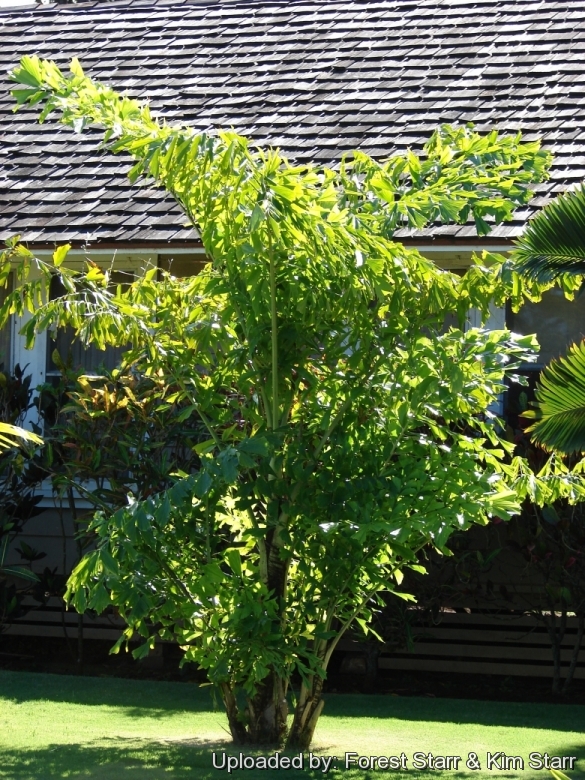
Caryota mitis Photo by: Forest Starr & Kim Starr
Habit at Spreckelsville, Maui, Hawaii (USA). January 11, 2007.
Origin and Habitat: India through to China, south-east Asia (Burma, Malaisia, indonesia) North Australia and Philippine Islands
Habitat: Tropical rainforests from where it grows as an understory plant in tropical rain forests.
Synonyms:
See all synonyms of Caryota mitis
back
Accepted name in llifle Database:Caryota mitis Lour.Fl. Cochinch. 697 1790Synonymy: 11
back
Common Names include:
ENGLISH: Clumping fish tail palm, Clustering Fishtail Palm, Burmese Fishtail Palm
FRENCH (Français): Caryote doux
GERMAN (Deutsch): Fischschwanzpalme
ITALIAN (Italiano): Palma cariota
MALAY (بهاس ملاي /Bahasa Melayu ): Dudar
SPANISH (Español): Cariota, Escariota, Palmera de sagú de Malabrar, ola de pez, Palmera de cola de pescado ramificada, Palmera cola de pez, Palma cola de pescado, Banda de sargento, Palmera de vino de la India, Palmera de hoja de cola de pez, Palma de cola de pescado
Description: This is a clustering spineless palm, which can form a tightly packed clump 4-8(-10) metres high and 4 metres across at the top with a bush-like appearance. It is the most widely grown of the Caryota genus. It produces suckers freely.
Trunks: About 15 cm across, slender, light green/grayish colour with quite widely spaced leaf nodes.
Leaves: Light to dark green, bipinnate that can reach 3 m in length, with roughly triangular leaflets, flat, deeply indented and lobed that open rather like a fishes tail. The leaves don't abscis when spent, but they are easily removed due to the palms size. The leaves are inclined to burn in full blazing sun with low air humidity.
Inflorescence: Panicles that arise from within and below the leaves.
Flowers: Unisexual, pale cream, perfumed, in groups of 3 ( l female, 2 male), with 3 sepals and 3 petals. Like other species in the genus, as well as the related genera Arenga and Wallichia each trunk produces flowers for several seasons, starting from the top of the trunk and moving downwards, but then dies after its final seeding and should be removed. The clump will survive, however, and continue to produce more stems.
Fruit: Attractive reddish-orange to dark-red (or even bluish-black?) globular berry 1-2 cm long, tropical-looking fruit (in abundance).
Bibliography: Major references
1) Forest & Kim Starr Caryota mitis (Clumping fish tail palm). Plants of Hawaii. <http://www.starrenvironmental.com>. Downloaded on 21 August 2014.
2) Don Ellison, Anthony Ellison “Cultivated Palms Of The World” UNSW Press, 01/mag/2001
3) Robert Lee Riffle, Paul Craft “An Encyclopedia of Cultivated Palms” Timber Press, Portland 2007
4) John Dransfield, Natalie W. Uhl, Conny B. Asmussen, William J. Baker, Madeline M. Harley, Carl E. Lewis: “Genera Palmarum. The Evolution and Classification of Palms.” Royal Botanic Gardens, Kew 2008
5) David Jones: “Palmen” Könemann, Köln, 2000
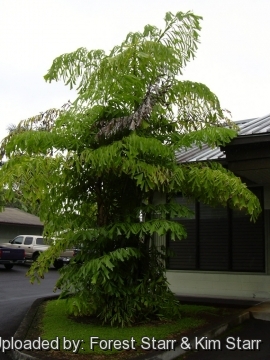 Habit at Hilo, Hawaii (USA). November 18, 2003. Photo by: Forest Starr & Kim Starr
Habit at Hilo, Hawaii (USA). November 18, 2003. Photo by: Forest Starr & Kim Starr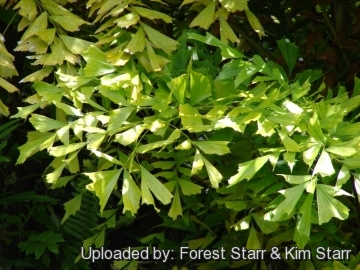 Leaves at Hana Gardenland, Maui, Hawaii (USA). March 21, 2007. Photo by: Forest Starr & Kim Starr
Leaves at Hana Gardenland, Maui, Hawaii (USA). March 21, 2007. Photo by: Forest Starr & Kim Starr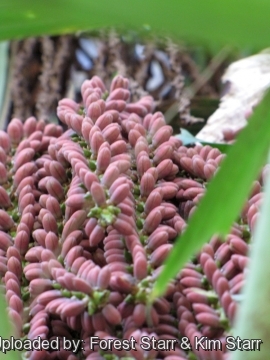 Flower stalk at Iao Tropical Gardens of Maui, Maui, Hawaii (USA). May 22, 2012. Photo by: Forest Starr & Kim Starr
Flower stalk at Iao Tropical Gardens of Maui, Maui, Hawaii (USA). May 22, 2012. Photo by: Forest Starr & Kim Starr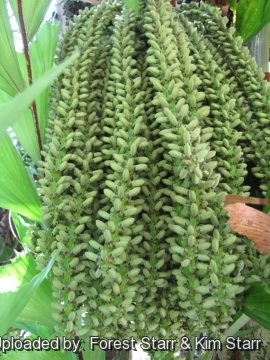 Flower stalk at Iao Tropical Gardens of Maui, Maui, Hawaii (USA). May 22, 2012. Photo by: Forest Starr & Kim Starr
Flower stalk at Iao Tropical Gardens of Maui, Maui, Hawaii (USA). May 22, 2012. Photo by: Forest Starr & Kim Starr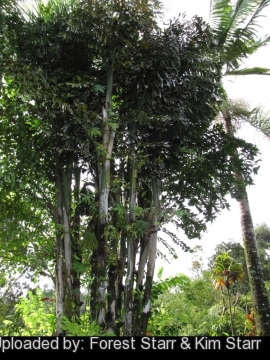 Habit at Garden of Eden Keanae, Maui, Hawaii (USA). March 30, 2011. Photo by: Forest Starr & Kim Starr
Habit at Garden of Eden Keanae, Maui, Hawaii (USA). March 30, 2011. Photo by: Forest Starr & Kim Starr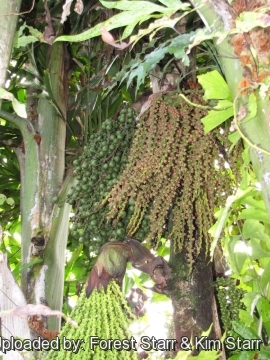 Flowers and fruit at Garden of Eden Keanae, Maui, Hawaii (USA). March 30, 2011. Photo by: Forest Starr & Kim Starr
Flowers and fruit at Garden of Eden Keanae, Maui, Hawaii (USA). March 30, 2011. Photo by: Forest Starr & Kim Starr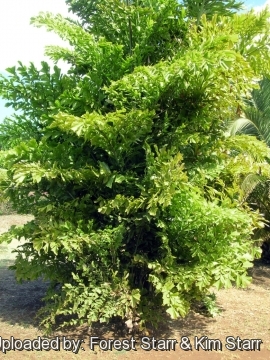 Habit at Enchanting Floral Gardens of Kula, Maui, Hawaii (USA). October 24, 2007. Photo by: Forest Starr & Kim Starr
Habit at Enchanting Floral Gardens of Kula, Maui, Hawaii (USA). October 24, 2007. Photo by: Forest Starr & Kim StarrSend a photo of this plant.The gallery now contains thousands of pictures, however it is possible to do even more. We are, of course, seeking photos of species not yet shown in the gallery but not only that, we are also looking for better pictures than those already present.
Read More... Cultivation and Propagation: It is a very useful and attractive plant for the gardener, easy to grow that features unusual leaf form, rapid, clustering growth, and a manageable height. It is a interior-scapers's mainstay palm for exotic and carefree tropical beauty,but is even better outside. It likes sandy soil, but is adaptable to clay and loam both slightly alkaline and acidic. Good drainage is also important. It is a medium fast grower, but it can grow fast given the right conditions of warmth and humidity, together with a rich soil and an abundance of water. Caryota mitisSN|24267]]SN|24267]] vary in shape. Specimens raised in dry and/or infertile soils tend to be smaller in stature with smaller leaves. Light also affects the plant's form while those grown in full sun are more compact. Because it is shallow rooted, it should be planted in an area protected from wind. This palm is perfect for understory planting in woodland areas.
Fertilization: Need a perfect fertilizer diet including all micro nutrients and trace elements or slow release fertilizer. Micronutrient deficiencies are occasional problems. If it doesn't get enough Mn and Fe, the leaves take on a rather unhealthy yellow colour. Micronutrient deficiencies only show up on soil with a high pH.
Water Requirements: It has a moderate drought tolerance, but for healthy growth it needs regular water, however it does not want to sit in continually wet, mucky soil. The roots and lower trunk can rot if soil is kept too moist.
Light: This attractive palm can be grown full sun to part shade, and even in shade.
Hardiness: It is one of the hardiest feather palms, tolerating temperatures down to about -2°C (or even less for short periods) when mature, young plants are more cold sensitive; it is widely cultivated in subtropical and warm temperate regions. Young plants grown in containers must be kept warmer than 4º C.
Maintenance: Prune diseased, damaged or drying fronds, but do not prune if the frond still has some green colour. Palms recycle nutrients from dead or dying fronds and use them for healthier fronds. Palms only have a set number of new leaves that can sprout and grow per year and removing fronds will not increase that number. If you cut off more than what will grow annually, you could be left with a pretty bare and bald palm.
Roots: Not a problem.
Uses: Either as a single specimen or in groups, this is a strikingly beautiful species. Its fabulous clustering habit makes it perfect a perfect screening palm (and not too tall) and is also used to accent residential landscapes. Can be grown indoors with only moderate, or average indoor light conditions.A shaded patio will provide an excellent environment for young specimens which can eventually be planted in the ground as the grow bigger.
Pests and diseases: It is relatively free of diseases and insect infestations.
Propagation: Fresh seeds germinate in 3 - 4 in warm media and the seedlings are attractive. Fishtail palm can also be propagated by division of clumps and separation of suckers from the parent clump.
Warning: Flesh of seed and trunk is caustic to touch and should be handled with care. It contains sharply pointed calcium oxalate crystals which are toxic when ingested, and contact with eyes and skin may result in severe burns. The fibrous hairs at the base of the leaf stalks produce a skin irritation.
















